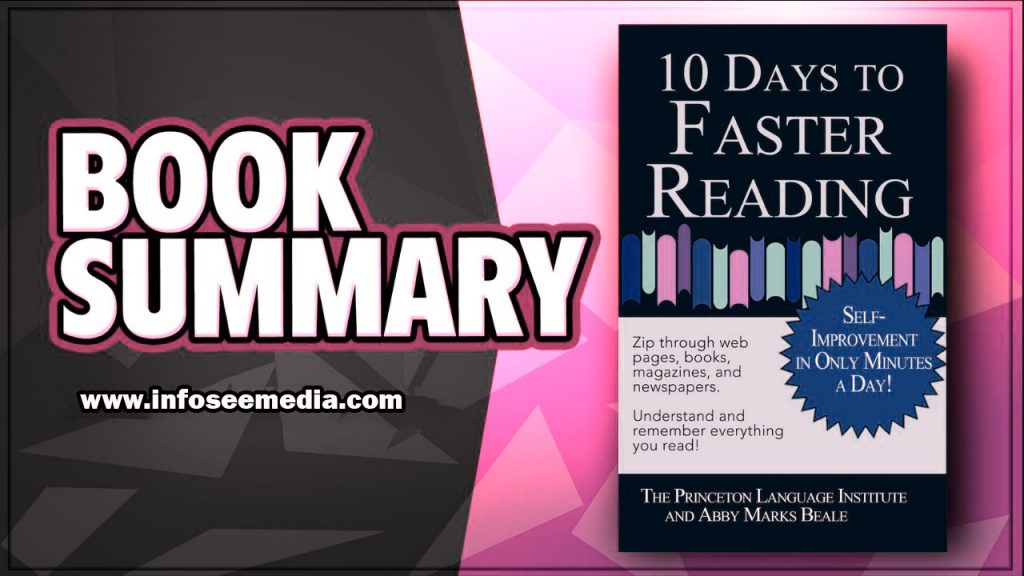This book 10 Days To Faster Reading is the outcome of a collaboration between the world’s foremost authority on fast reading and the Princeton Language Institute. Over the course of ten days, it guides you through a series of reading tests designed to reveal your reading habits, both good and bad, and the reading strategies you’ve already learned.
This book provides a lifeline for anyone who feels they are too busy, distracted, or forgetful to read effectively.
You can improve your reading skills by following these three steps:
- Just ask a few questions before diving in.
- Always skim before you read.
- To understand something without reading it, memorize crucial phrases.
Lesson 1: Ask these two questions to limit your reading.
Being a prolific reader isn’t the same as reading everything that comes your way; it’s more like reading the right things at the right times and at the right speeds.
If you want to read more, skip the information that isn’t essential. Reading is similar to maintaining a healthy diet in that you have to be accountable for what you put into your body; in this case, it’s your brain.
Before reading anything longer than a tweet, the writers recommend you ask yourself these two essential questions.
When did I start reading this?
Why do I need the information given here?
You can tell if you’re trying to please someone else with your response to the first question or if you really want the satisfaction of checking off “I have read it” on your own list. For instance, if you haven’t read the 2014 market report in the last two years, there’s no reason to start now.
The second probes into how likely you are to put the information to use. If your child already has a high GPA, you shouldn’t waste time reviewing their schoolwork in favor of reading a scientific study that can help you solve a critical problem for one of your clients.
Lesson 2: A glimpse may be enough.
Fiction books are an exception, but this works wonderfully with nonfiction of all kinds. An abstract can help you choose whether a book or article is worth reading in its entirety and which sections will be most useful to you.
You don’t have to read everything that lands in your hands, and you certainly don’t have to read everything in anything you do read.
How? Read on! Skim the index and read the foreword and text on the rear flap. The next step is to peruse the chapter titles and subheadings. Try reading the introduction to any paragraphs or chapters that catch your eye.
Doing so will prepare you for what’s to follow, reducing the need to go back and reread individual lines and paragraphs as you go.
The authors claim that previewing can provide as much as 40 percent of the data, which is often sufficient for the reader’s purposes. The central idea of a book like “The One Thing” may be grasped in about five minutes. Not because the rest of the book is horrible or unimportant, but it may be all you need right now.
Lesson 3: Focus on crucial words to understand sentences without reading.
You could look at the entire lesson that was just presented and immediately tell me what the most important thing to learn from it is without having to read a single sentence.
Why is it the case?
Because I’ve highlighted what I consider to be the most significant terms in bold. You can get a good idea of what the book is about by glancing at the title, the foreword, the text on the back flap, and the index. All you need to do is take a quick look at the paragraph that came before this one.
When we read, our eyes tend to wander all over the page, but if you keep your focus on a steady stream of keywords, you will be able to read more fluidly. The meaning of the sentence is typically carried by these keywords, which are typically longer than three letters.
This strategy is simpler to implement in written works that highlight certain passages (such as this overview), but with little practice, you will be able to use it even in the absence of any specific visual direction.
To whom should I recommend this book?
- The 15-year-old student despises having to memorize information from textbooks in order to succeed in school.
- The individual at the age of 54 believes that experience is the only way to learn and that reading at work is a waste of time.
- Those who would feel guilty about giving up on a book eventually realized they did not enjoy reading.
10 Days To Faster Reading Book Review
I was anticipating a bunch of questionable strategies for fast reading, but this turned out to be helpful! I enjoy how the emphasis is placed on prioritizing what you read and making adjustments to it in the first place. After that, “10 Days To Faster Reading” discusses both unhealthy reading habits and healthy reading habits, making it simple to differentiate between things that should be avoided and things that should be strived for. The section on speed reading contributes more to the overall feel of the book as opposed to being the primary focus of it.

